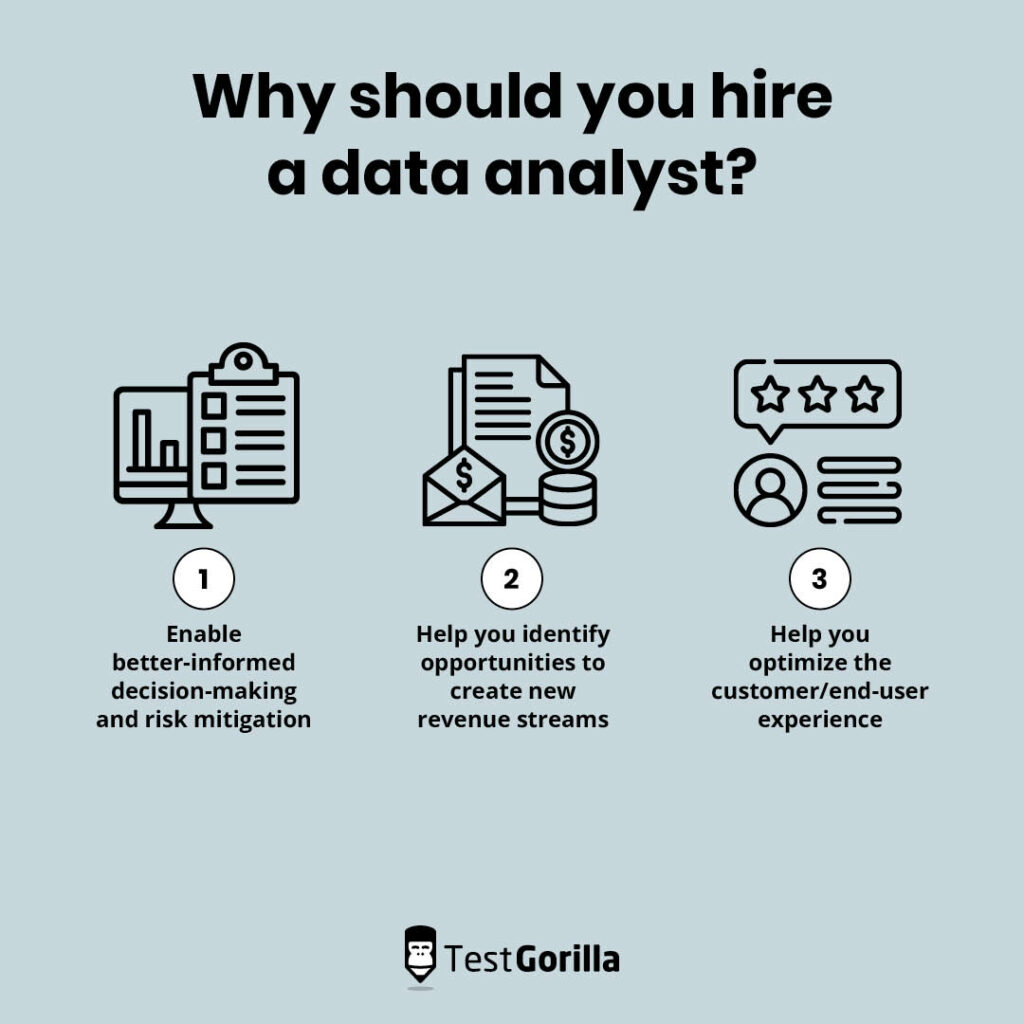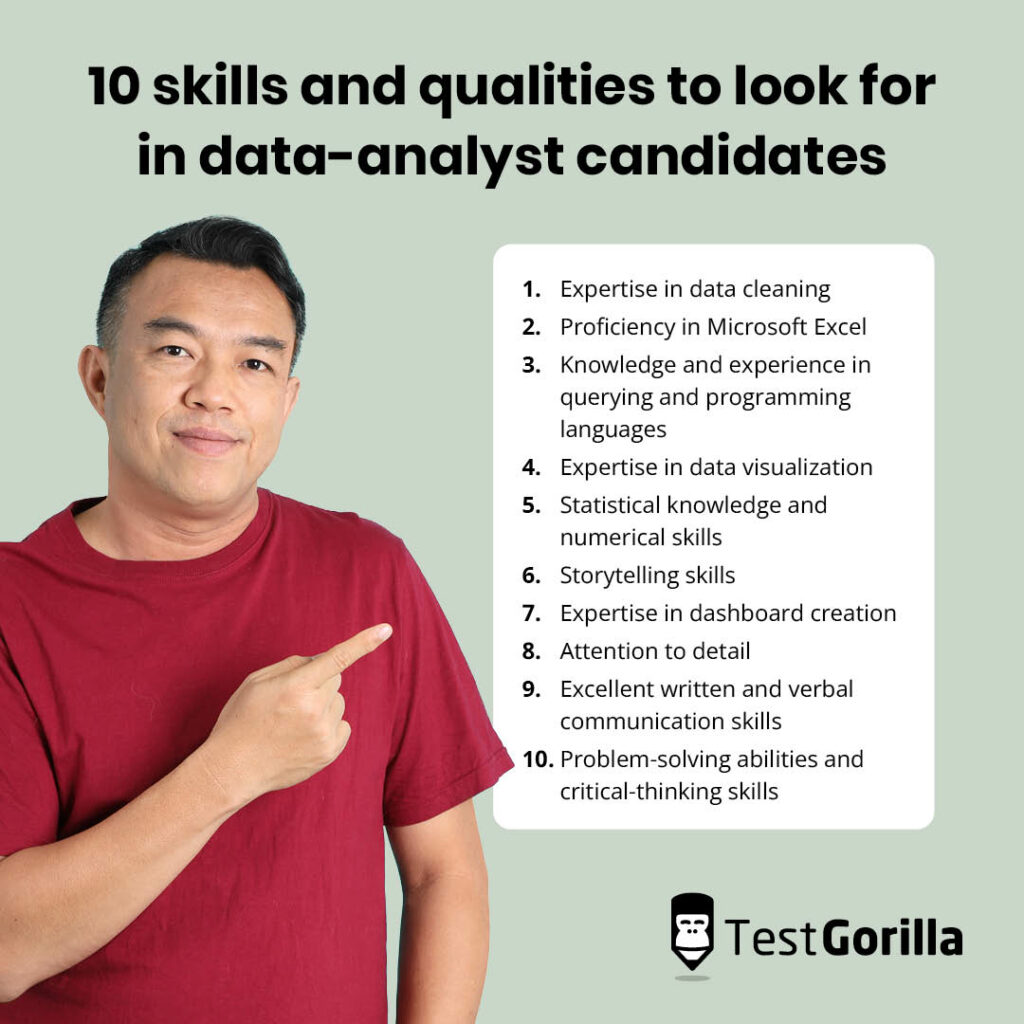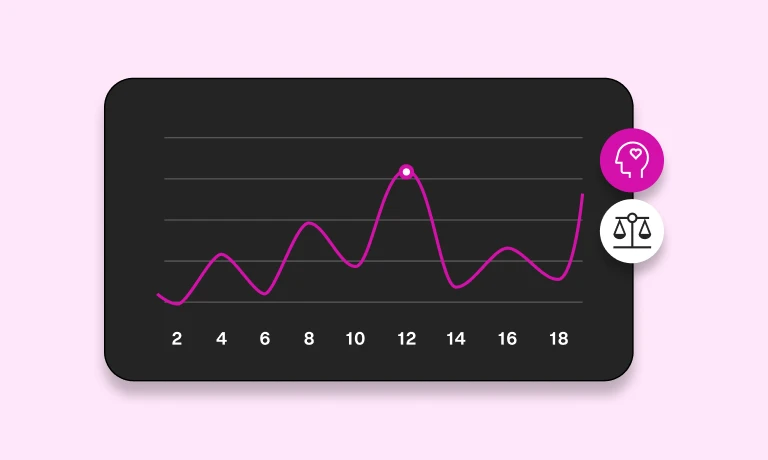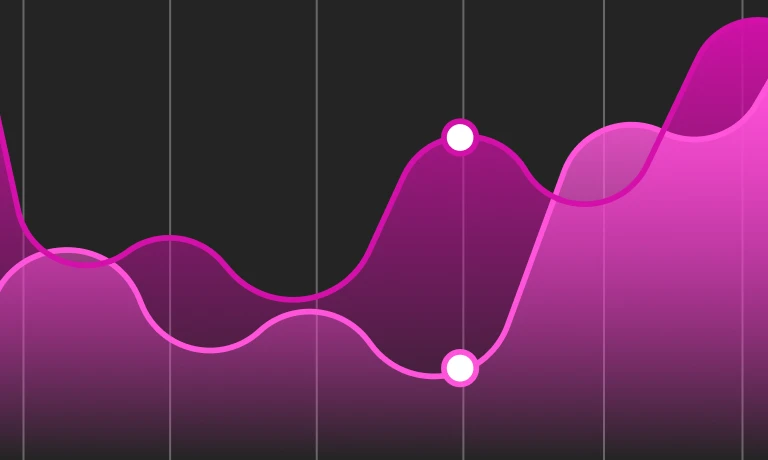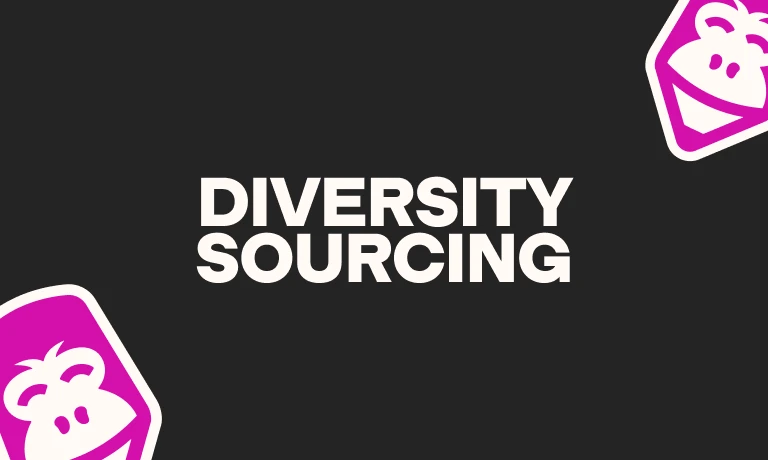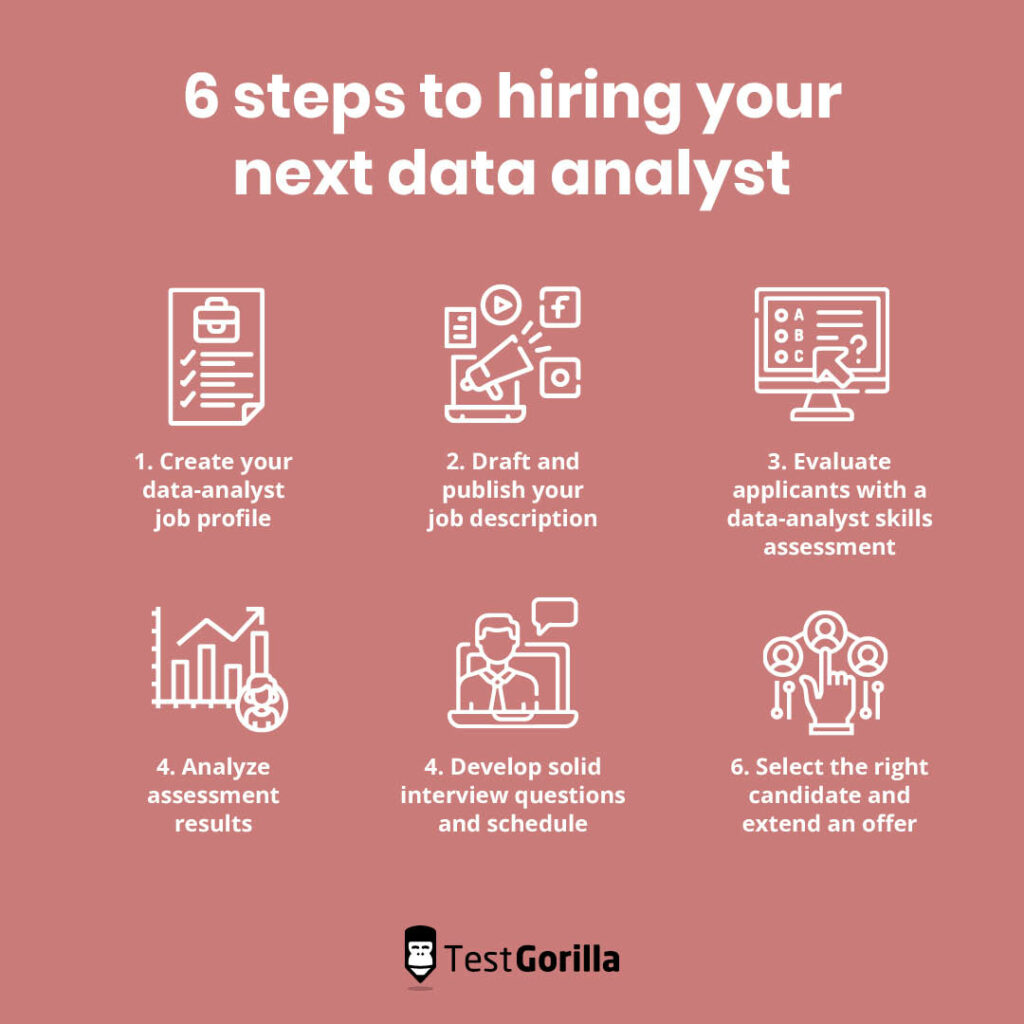Data analysts are in high demand. According to the Bureau of Labor Statistics, the employment of research analysts (including data analysts) is expected to increase by 23% from 2019 to 20311. When compared with most other occupations, this is a rapid growth rate.
However, the role of a data analyst is also changing and becoming more complex. The integration of machine learning means that data analysts have more access to task automation processes and are in higher demand than ever for providing analysis, insights, and storytelling.
On top of this, the data analytics skills shortage has led to organizations competing for the same candidates2. With this in mind, you might be wondering how to hire the best data analysts who can turn raw data into actionable insights for your business. In this guide, we’ll walk you through everything you need to know – from the top data analyst skills and how to write a great job description to where you can find the best data analysts and how to test candidates’ skills using TestGorilla’s unique test library.
Table of contents
- What is a data analyst and what do they do?
- Why should you hire a data analyst?
- Data-analyst job responsibilities
- Data-analyst job requirements and skills
- 10 skills and qualities to look for in data-analyst candidates
- How to craft a compelling data analyst job description
- Where can you find top data-analyst candidates?
- 6 steps to hiring your next data analyst
- Make hiring a top data analyst a breeze with TestGorilla’s skills assessments
What is a data analyst and what do they do?
Data analysts are responsible for gathering, cleaning, analyzing, interpreting, and presenting data visualizations to help solve business problems and provide organizations with valuable insights. They’re also responsible for identifying trends and patterns in data and producing both internal and external-facing reports.
Data analysts use a variety of tools, such as Power BI and Tableau, to both automate the collection of data and tasks and gather and display data efficiently using dashboards. Data analysts also need experience with programming languages, such as SAS, R, Stata, and Python, to help them transform, manipulate, and visualize data.
Data analysts work across many industries, analyzing sales figures, profit margins, advertising and marketing data, and health data.
Why should you hire a data analyst?
All businesses sit on a wealth of data that contains valuable insights into how they can optimize business processes, operations, and strategies. Although some software tools help to make sense of their data, professional data analysts can interpret the information and present their insights as answers to problems, rather than as just numbers.
Here are just a few reasons why hiring a data analyst can improve your business’s performance.
1. They enable better-informed decision-making and risk mitigation
Data analysts interpret business data to help you make evidence-based decisions and build strategies based on predictive analytics.
For example, good analysis can help you identify bottlenecks and guide your strategy on how to minimize financial losses stemming from them.
Data analysts can also use predictive modeling to enable you to anticipate what might happen if you make certain choices or if potential events were to occur. They’ll use prescriptive analytics to help you decide how to respond to such situations.
2. They help you identify opportunities to create new revenue streams
Data analysts can also identify opportunities to create new revenue streams and increase sales, as well as determine how to target product and service offerings to particular people.
Good professionals will help take the guesswork out of directing business strategy, therefore helping you to maximize revenue.
3. They help you optimize the customer/end-user experience
Depending on your industry, delivering optimal to customers or end users will be one of your main priorities. Data analysts help you understand customer/end-user behavior so that you can augment and personalize services or products, and they will indicate the operational changes you need to achieve this.
The best insights on HR and recruitment, delivered to your inbox.
Biweekly updates. No spam. Unsubscribe any time.
Data-analyst job responsibilities
A data analyst’s job responsibilities will differ depending on the specific project you hire them to work on.
In general, however, data analysts’ responsibilities can be relevant to most industries. These include:
Identifying, analyzing, and drawing conclusions from raw data
Using software to automate data collection and modification
Sourcing missing data
Spotting and predicting trends or patterns in complex data sets
Developing, updating, and automating reports and dashboards using visualization tools
Analyzing and reviewing report/data requests for clarity and content
Developing, implementing, and maintaining databases
Assessing the quality of data and removing or cleaning data
Delivering presentations to clearly and effectively communicate findings to non-technical colleagues and stakeholders
Data warehousing
Setting up data infrastructure
Data-analyst job requirements and skills
The data-analyst job requirements and skills will differ depending on your business needs and the industry you work in. When it’s time to write your data analyst job description, you’ll also need to carefully consider what level of experience the successful candidate will need.
Here are a few standard data-analyst job requirements and skills you can edit to match your needs:
Bachelor’s degree (or equivalent) in mathematics, computer science, economics, or statistics
Strong programming experience with frameworks including XML, JavaScript, and ETL
Coding skills in languages such as SAS, R, Stata, or Python
Advanced knowledge of SQL and Excel functions
Experience creating databases and developing existing frameworks
Experience with data-visualization tools such as Power BI and Tableau
Ability to present work to technical and non-technical teams for approval
Experience with supervised and unsupervised machine-learning techniques
Solid planning, priority setting, and project-management skills
Excellent verbal and written communication skills
10 skills and qualities to look for in data-analyst candidates
The ideal data-analyst candidate will have a good mix of technical skills and soft skills necessary to perform their duties and boost business performance.
Here, we take a look at the essential technical and soft skills to look for when hiring a data analyst.
1. Expertise in data cleaning
Effective data cleaning is an essential data-analyst skill. This process involves removing or fixing incorrect data, rectifying corrupt or incorrectly formatted data, and deleting duplicate data within a dataset.
All data-analyst candidates – whether junior or senior – should be well-versed in data-cleaning techniques.
2. Proficiency in Microsoft Excel
Data analysts use Microsoft Excel every day to clean, aggregate, pivot, manipulate, and graph data. Top data-analyst candidates will be advanced Excel users and should be familiar with the following features and functions:
Pivot tables and pivot charts
IF function
CONCATENATE
Conditional formatting
Remove duplicates
SUMIFS
COUNTIFS
XLOOKUP
IFERROR
MATCH
COUNTBLANK
RANK
SUMPRODUCT
3. Knowledge and experience in querying and programming languages
Data analysts need to be familiar with querying languages in order to extract information from relational and multidimensional databases. Data analysts need experience with querying languages – such as SQL and SAS – to access, organize, and analyze data in order to detect patterns and provide valuable insights.
They will also need experience with one or more programming languages to be able to clean, manipulate, analyze, and transform data.
4. Expertise in data visualization
One of a data analyst’s main responsibilities is transforming complex data into digestible formats for a range of audiences. Experience with tools like Tableau or Power BI is crucial for effectively representing data and findings in visual formats.
5. Statistical knowledge and numerical skills
Data analysts will need a solid foundation of statistical knowledge and numerical skills in order to decipher complex data and avoid errors.
6. Storytelling skills
Data analysts also need to have strong data storytelling skills. They should be able to build a narrative around the insights gleaned from data to help others translate them into business actions and solutions.
7. Expertise in dashboard creation
Data analysts are tasked with delivering data insights to others to make business decisions. Great data-analyst candidates will be well-versed in building dashboards to represent data, including filters and interactive data points.
8. Attention to detail
Since data analysts work with large datasets, they need a keen eye for detail to ensure that business decisions are made on the basis of clean, accurate, and reliable data.
9. Excellent written and verbal communication skills
The best data-analyst candidates have strong written and verbal communication skills. This enables them to effectively convey and break down important and complex information to a wide range of audiences.
Whether they need to lead a presentation or compile reports, data analysts must come equipped with well-honed communication skills to help decision-makers implement the best business strategies.
10. Problem-solving abilities and critical-thinking skills
Data analysts need strong problem-solving skills to solve complex technical challenges and overcome roadblocks. Critical-thinking skills also help them identify the best way to solve problems and pursue new opportunities.
How to craft a compelling data analyst job description
Now that you know which skills and qualities to look for in your ideal candidate, it’s time to draft an eye-catching data analyst job description that will attract the best candidates.
Here’s what you should include:
An informative job title. Are you hiring for a senior or junior data analyst? Do they need any industry-specific or role-specific experience? Are you looking for an in-house or freelance data analyst?
Make it clear exactly what you’re looking for in the job title to establish the level of responsibility and expectations early on. For example, instead of “data analyst,” consider “senior data analyst” or “people analytics (in-house).”
A brief overview of your company. This should include a short summary of what your company does, its aims and mission, the sector/industry you work in, and a brief overview of your company culture. These will give potential applicants a better idea of your business and help you attract the right candidates.
An overview of the data-analyst role. Provide details about the projects the successful candidate will work on and the impact the role will have on the business.
For example: “The successful candidate will provide technical and analytical expertise in data cleansing, advanced report compilation, dashboard creation, and interpreting and summarizing data to identify cost-saving initiatives and bottlenecks in business operations.”
Job responsibilities. To avoid unsuitable applicants from applying, you should describe exactly what the role entails. This will include everyday responsibilities, duties, and tasks that the successful candidate will carry out.
The skills, experience, and qualifications required for the role. List both the technical and soft skills you’re looking for. Include clear information about the level of experience and qualifications the ideal candidate will possess.
Your company’s location and working hours. Indicate whether the role is remote, hybrid, or in-person. If remote working is an option, include your core working hours to ensure that overseas applicants can determine whether the role is suitable for them.
Compensation, perks, and benefits. Be upfront about the salary range you can offer to make sure you attract the right candidates. You should also list any employee perks and benefits to help your company stand out from your competitors.
Details about the hiring process. Be clear about what applicants can expect from your hiring processes, including how many interview rounds there will be, and whether you will conduct any pre-employment assessments.
Don’t forget to include information about compensation, which can be critical in identifying and reeling in top industry talent. If you’re unsure about what to pay a data analyst, check out our handy guide here. And for a more in-depth look at how to write a compelling job description, check out TestGorilla’s guide on writing great job descriptions.
Where can you find top data-analyst candidates?
Whether you want to hire a data analyst for a specific project or you’re looking to hire a full-time, in-house employee, you will need to consider whether you want to hire an in-house or freelance data analyst.
There are various platforms where you can find great data analyst candidates. Let’s take a look at some of the most common places to hire and recruit top data analysts.
1. LinkedIn Jobs
LinkedIn is a great place to start your search for both freelance and in-house data analysts. It’s the world’s largest professional network, which means you have access to the profiles of data analysts all over the world.
Depending on your needs, the platform’s search filters help you narrow down the results for the best data analysts. Plus, if you subscribe to LinkedIn premium, you can send InMails to reach candidates outside of your core network.
You can also list your data-analyst job opening and description on LinkedIn so that applicants can apply through the platform.
2. GitHub
GitHub is the world’s largest software-development platform and is also a great place to find talented data analysts with the skills you need. There are currently over 35,000 data analysts on GitHub which makes it a great source for candidates who match your ideal profile.
After signing up to GitHub, you can use the platform’s built-in search engine and advanced search options with a broad range of filters to search for data analysts that suit your requirements. Since many users display their email addresses, you can often contact them directly.
3. TopTal
TopTal is a hub for data analysts, developers, designers, and other specialties with a network of top freelance data analysts across the world. Members of Toptal’s network are thoroughly tested and vetted before they can become potential candidates for hire.
To find a data analyst via this platform, just submit a job description and TopTal’s experts will search for the ideal candidate for the position. If you hire a data analyst who ends up being the wrong match for your needs, Toptal offers a money-back guarantee.
4. Dataspace
Dataspace was created as a business intelligence consulting agency that now also offers data-analyst recruiting services.
This platform can help you find both temporary and permanent data analysts who are screened by experts. Once you submit a job description to Dataspace, they present you with a shortlist of candidates from which to choose.
5. Employee referral programs
Employee referral programs are a recruiting method that helps you source candidates through connections with your existing employees. Research shows that employees hired through referral programs are more likely to stay longer at the company and perform better than those employed through other methods.
Your existing employees are already a great culture add to your business. This means that you can rest assured that your employees will refer people they think would suit the role and the company culture.
6 steps to hiring your next data analyst
Now that we’ve detailed the responsibilities and skills of data analysts, how to write a great job description, and where to find top candidates, it’s time to put this into practice and start hiring your next data analyst.
Here are six simple steps for hiring the perfect data analyst for your team.
1. Create your data-analyst job profile
Before you can write and publish your data analyst job description, you’ll need to create a job profile. This will help you identify what the right candidate will look like and streamline your hiring process.
Sit down with the hiring team and other relevant stakeholders to determine what objectives hiring a data analyst will help the business achieve, which projects or areas they will work in, and the impact you expect them to make.
Since data analysts have varied backgrounds and expertise in different sectors/industries, try to be as specific as possible when creating your data-analyst profile.
Based on this profile, you’ll can then define the list of requirements, experience, and skills your prospective employee will need.
Finally, set a salary level and include any benefits, bonuses, and company perks.
2. Draft and publish your job description
Once you’ve created a data-analyst profile, it’s time to create a job description and publish it. Remember to include:
An informative job title
An overview of the role
An introduction to your company
Details about working conditions
Information about the relevant skills, competencies, and experience you require for the role
Information about compensation, company, benefits, and perks
Details about the hiring process
When you’re ready to publish, remember to post the job description on LinkedIn, GitHub, TopTal, and Dataspace. You’ll also want to post the job to your employee referral program and your careers website.
3. Evaluate applicants with a data-analyst skills assessment
Soon after you publish your job description, you’ll begin receiving applications. From here, you’ll need to begin the process of evaluating applicants’ skill sets.
However, evaluating every applicant’s resume manually – or even using resume-screening tools – is a time-consuming process that can also lead to biased candidate selection.
To find the right candidate and minimize time-to-hire metrics, smart businesses are implementing skills-based hiring practices. These involve defining the specific skills a role requires and screening candidates based on whether they have those skills.
This will help you identify the right data-analyst candidates from the outset and reduce the time you spend considering applicants that don’t meet your requirements.
To support skills-based hiring practices, you’ll need a robust tool that can help you evaluate candidates’ technical and soft skills. With TestGorilla, you’ll find it easy to start creating skills assessments for your data-analyst candidates to make sure they fit your profile.
How to create a customized data-analyst assessment
TestGorilla offers several tests that evaluate data-analyst candidates’ technical skills, including:
The Working with Data test assesses candidates’ understanding of data-handling concepts, their skills in performing basic data analysis and interpretation, and their skills in working with graphs.
The Data Analytics in Excel test evaluates candidates' ability to perform data analysis tasks using Excel functions and formulas, data cleaning with text functions and date/time operations, data visualization, and data validation skills.
The SQLite (coding): intermediate-level querying test reviews candidates’ skills in creating a query on a database with medium complexity.
The Power BI test evaluates candidates’ abilities with Power BI online, data modeling in the query editor, data relationships and DAX, and data visualization.
The Tableau test assesses candidates’ skills when using the software to connect and manage data, create and perform advanced calculations, and build user dashboards.
The Python (coding): entry-level algorithms test examines candidates’ basic programming skills by asking them to program a small algorithm in Python.
We recommend creating a holistic assessment that can test candidates’ soft skills and evaluate their full profiles. You can add a selection of Personality tests, Cognitive Ability tests, and Situational Judgment tests to help you glean deeper insights into your candidate profiles, which will help you hire a data analyst that meets all your business needs.
Once you’ve created the assessment, you can then easily invite applicants to complete it through a single or bulk email or through public links that you can display on the job application form.
4. Analyze assessment results
After all your candidates have completed the assessment, you can begin analyzing the results and identifying which candidates to interview.
To make this process more efficient, TestGorilla ranks your candidates from high to low based on their average scores.
Additionally, since an assessment is made up of several different tests, our analysis provides granular insights to help you judge which elements or areas are most important.
Finally, you can summarize each candidate’s evaluation by assigning them a final star rating and recording your own notes. From here, you’re ready to narrow down the list of candidates who will move on to the interview process.
5. Develop solid interview questions and schedule interviews
Once you’ve analyzed the results of the skills assessment and identified a shortlist of applicants best suited for your data-analyst role, you’ll need to prepare interview questions that can help you glean more information about each candidate.
To help you further evaluate candidates’ knowledge, experience, and skills, here are six data-analyst interview questions you could ask during interviews.
What are the different types of hypothesis testing?
Candidates should be able to relay the two main types of hypothesis testing that can accept or reject statistical hypotheses.
The first is a null hypothesis, which means that there is no relation or statistical significance between sets of data or variables. The second is an alternative hypothesis, which means that there is some relation between sets of data or variables.
What are the different types of sampling techniques used by data analysts?
Candidates should be able to name the different types of sampling techniques used to select, manipulate, and analyze a subset of data points to reveal meaningful insights.
Candidates should mention the following sampling methods:
Simple random sampling
Cluster sampling
Stratified sampling
Systematic sampling
Judgmental or purposive sampling
How do you handle missing data?
Candidates must be able to demonstrate how they would manage a situation where data is missing.
Some methods candidates may mention include:
Regression substitution to estimate a missing value
Average imputation to help fill in the missing value
Listwise detection to exclude an entire record from analysis
Creating a validation report that contains details about the missing data
What is the difference between data profiling and data mining?
Candidates should be able to explain that while data profiling is the process of examining and summarizing data from an existing, specified source, data mining is the process of exploring data in order to generate statistics and extract insights.
How do you communicate technical concepts to a non-technical audience?
Answers to this question will help you evaluate candidates’ storytelling, and technical skills, as well as their verbal and written communication.
Candidates should be able to talk you through and give examples of how they can effectively relay their findings and insights to colleagues or clients without a data-science background.
Which soft skills are you working on that can benefit your role as a data analyst?
Candidates should explain which soft skills they have – including storytelling, communication, and time-management skills – that can benefit their role as data analysts. They should also be able to describe how they are actively working on some of these soft skills.
Want more inspiration? Explore our expert’s guide to interview questions for data-driven decision-making.
6. Select the right candidate and extend an offer
After you’ve interviewed your top candidates, you’re ready to select your best candidate. Once your hiring team is in agreement, you can extend an offer to the successful candidate, which should include salary and benefits information, your expected start date, and any details about a probationary period.
To make sure that all your candidates have a positive candidate experience, provide the unsuccessful candidates with constructive interview feedback.
Make hiring a top data analyst a breeze with TestGorilla’s skills assessments
Data analysts transform hoards of data into meaningful insights to help your business grow and thrive. However, the shortage of data-analytics skills combined with the ever-evolving data-analyst role means that companies need to start implementing pre-employment testing in their recruitment processes to ensure they’re hiring top talent.
Resumes can’t demonstrate real, practical data-analyst skills – but skills-based hiring practices can.
TestGorilla’s range of analytics-related tests helps you quickly identify which candidates have the right level of expertise for your open role. Plus, by combining these technical tests with other Cognitive Ability and Situational Judgment tests, you can easily pinpoint candidates with the right combination of hard and soft skills.
Sign up for TestGorilla’s free plan today and start using our wide-ranging test library to create a comprehensive skills assessment and hire the perfect data analyst for your open role.
Sources:
Operations Research Analysts : Occupational Outlook Handbook: U.S. Bureau of Labor Statistics. (2023, February 6). https://www.bls.gov/ooh/math/operations-research-analysts.htm
Ramachandran, K., & Watson, J. (2021, May 7). Tech looks to analytics skills to bolster its workforce. Deloitte Insights. https://www2.deloitte.com/us/en/insights/industry/technology/data-analytics-skills-shortage.html
You've scrolled this far
Why not try TestGorilla for free, and see what happens when you put skills first.


